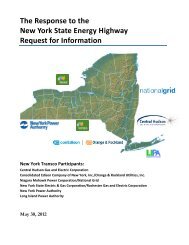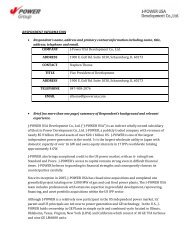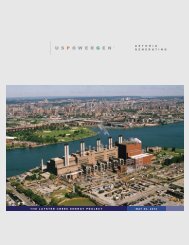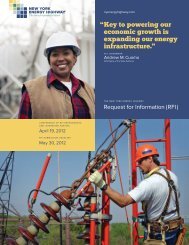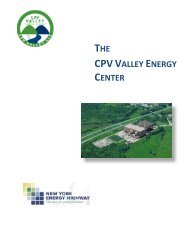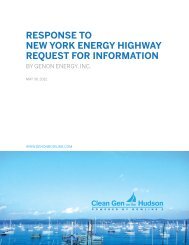Applied Materials - Energy Highway
Applied Materials - Energy Highway
Applied Materials - Energy Highway
You also want an ePaper? Increase the reach of your titles
YUMPU automatically turns print PDFs into web optimized ePapers that Google loves.
New York State <strong>Energy</strong> <strong>Highway</strong> (NYSEH) RFI Submission<br />
Use of Varian Power Systems (VPS) Superconducting Fault Current<br />
Limiters (SCFCLs) to surgically mitigate excessive fault current levels that<br />
would otherwise interfere with desired elements of the NYSEH initiative<br />
RESPONDENT INFORMATION<br />
Paul J. Murphy, Ph.D., G.M. Varian Power Systems<br />
<strong>Applied</strong> <strong>Materials</strong><br />
35 Dory Road, M/S 14<br />
Gloucester, MA 01930-2297<br />
Telephone: 1 978 282 7522<br />
Email: Paul_Murphy@amat.com<br />
Mr. Murphy obtained his Ph.D. in Physics in 1993 and has vast experience<br />
in Guidance Systems, Scientific Instruments, Space and Satellite Design<br />
and High Voltage Systems. Paul has held various senior level positions in<br />
Engineering with Varian since 1997 and is currently G.M. of Varian Power<br />
Systems Group of <strong>Applied</strong> <strong>Materials</strong><br />
About Varian Power Systems, a division of the Varian Semiconductor<br />
Equipment Business Unit of <strong>Applied</strong> <strong>Materials</strong>, Inc.<br />
<strong>Applied</strong> <strong>Materials</strong> is the global leader providing innovative equipment,<br />
services and software to the semiconductor, flat panel display and solar<br />
photovoltaic industries<br />
<strong>Applied</strong> has over 14,000 employees in 87 locations in 19 countries with<br />
annual revenue in excess of $11 Billion. <strong>Applied</strong> has the intellectual capital,<br />
financial resources and capability to help customers integrate and<br />
manufacture advanced technology around the world.<br />
Varian Power Systems (VPS) develops and manufactures critical power<br />
system solutions for the utility market. These solutions combine the<br />
company’s visionary leadership with experience in high voltage engineering<br />
design, power systems integration and systems engineering. The Varian<br />
1
Business Unit has been ranked by VLSI Research as number one in<br />
customer satisfaction for 14 of the last 15 years.<br />
NEWSWEEK Magazine’s<br />
Top Greenest Companies<br />
Ranks No. 3 in Industry on<br />
FORTUNE Magazine's<br />
World's Most Admired<br />
Companies List<br />
Named one of the Most Innovative<br />
Companies<br />
in the World<br />
PROJECT DESCRIPTION<br />
BACKGROUND INFORMATION ON FAULT CURRENT LIMITERS<br />
Fault Current Limiters (FCLs) are a new type of power equipment that<br />
protect power system equipment from extremely large mechanical,<br />
magnetic and thermal stresses that can occur when an electrical fault<br />
creates a low impedance path across other power system equipment or to<br />
ground. These stresses almost instantly concentrate, since all the<br />
electrically connected power sources on the entire power system are<br />
immediately drawn to the low impedance path created by the fault.<br />
Sometimes currents on the order of 63,000 amps occur on transmission<br />
systems (e.g. 138kV and 345kV systems) and 40,000 amps on selected<br />
dense urban distribution systems (New York City’s 13kV system).<br />
The new functionality provided by FCLs is even more critical as capacity<br />
increases to serve larger loads. This situation inherently adds to both<br />
system-wide and local fault current magnitudes. As distributed generation<br />
and energy storage proliferate, power systems must ―ride through‖ periodic<br />
faults to provide necessary capacity and functionality during periods of<br />
peak demand.<br />
2
[NEXT 3 HEADINGS AND FIGURE ARE PARTIALLY EXCERPTED FROM<br />
THE DOE FCL FACT SHEET]<br />
What are FCLs?<br />
A fault is an unintentional short circuit, or partial short-circuit, in an electric<br />
circuit. A variety of factors such as lightning, downed power lines, or<br />
crossed power lines cause faults. During a fault, excessive current—called<br />
fault current—flows through the electrical system often resulting in a failure<br />
of one section of that system by causing a tripped circuit breaker or a blown<br />
fuse. A fault current limiter (FCL) limits the amount of current flowing<br />
through the system and allows for the continual, uninterrupted operation of<br />
the electrical system, similar to the way surge protectors limit damaging<br />
currents to house-hold devices.<br />
Why Do We Need FCLs<br />
The need for FCLs is driven by rising system fault current levels as energy<br />
demand increases and more distributed generation and clean energy<br />
sources, such as wind and solar are added to an already overburdened<br />
system. Currently, explosive fault-limiting fuses are utilized to limit fault<br />
current, but they require a service call to replace the fuse after it blows and<br />
they are only available for voltages below 35 kV. Series reactors are also<br />
used but they have constant high reactive losses, are bulky, and contribute<br />
to grid voltage drops. FCLs overcome these weaknesses. Additionally,<br />
rising fault current levels increase the need for larger and often costly high<br />
impedance transformers. However, in contrast to these transformers, FCLs<br />
operate with little to no impedance during normal operation which allows for<br />
a more stable system.<br />
3
What Are The Benefits To Utilities?<br />
FCLs offer numerous benefits to electric utilities. For instance, utilities<br />
spend millions of dollars each year to maintain and protect the grid from<br />
potentially destructive fault currents. These large currents can damage or<br />
degrade circuit breakers and other expensive T&D system components.<br />
Utilities can reduce or eliminate these replacement costs by installing<br />
FCLs. Other benefits include:<br />
• Enhanced system safety, stability, and efficiency of the power<br />
delivery systems<br />
• Reduced or eliminated wide-area blackouts, reduced localized<br />
disruptions, and increased recovery time when disruptions do occur<br />
• Reduced maintenance costs by protecting expensive downstream<br />
T&D system equipment from constant electrical surges that degrade<br />
equipment and require costly replacement<br />
• Improved system reliability when renewables and DG are added to<br />
the electric grid<br />
• Elimination of split buses and opening bus-tie breakers<br />
• Reduced voltage dips caused by high resistive system components<br />
• Single to multiple shot (fault) protection plus automatic resetting<br />
4
VPS’ Superconducting Fault Current Limiter and the NYSEH<br />
VPS’ Superconducting Fault Current Limiter (SCFCL) can mitigate<br />
increased fault currents arising from additional generation and<br />
upstate/downstate transmission throughput that could otherwise<br />
increase local fault duties both within the New York City load center and<br />
in other state power systems that would be accommodating increased<br />
throughput within their service areas. Unmitigated increases in fault<br />
duties beyond current local system and equipment ratings could<br />
potentially lead to circuit breaker failures, flashovers, or physical bracing<br />
failures, which then could potentially cause multiple faults or significant<br />
loss of life to electrical power system components, as well as reliability<br />
impacts due to overtripping and/or extended equipment replacement or<br />
repair outages. In addition the restrictions on interconnection caused by<br />
fault current limitations can have direct negative impacts on the<br />
accomplishment of most of the intended objectives of NYSEH initiative.<br />
The selective application of fault current limiters can provide not only<br />
cost advantages through its relatively lower cost and losses for<br />
selective application versus Series Reactor, FACTS and HVDC<br />
alternatives, but can be more quickly designed and installed to respond<br />
to unanticipated loop flows or impacts of other changes on the power<br />
grid.<br />
The project(s) would involve selective application of Varian Power Systems’<br />
(VPS’) unique Superconducting Fault Current Limiter (SCFCL) design to<br />
mitigate generation, transmission or distribution fault currents either in a<br />
standalone project or in conjunction with any proposal accepted by the<br />
NYSEH Task Force. Many of the proposals that will be submitted to the<br />
NYSEH Task Force if implemented will exacerbate the existing fault current<br />
problems which will undermine the goals or substantially increase the<br />
required scope or cost of accepted proposals within the NYSEH initiative.<br />
PROJECT DESCRIPTION<br />
• Type of proposed project: Can be applied to generation, transmission<br />
and/or distribution or combination thereof, as needed.<br />
5
• Size of proposed project, with expected capability in energy and<br />
capacity: will be dictated by the needs of the New York State <strong>Energy</strong><br />
<strong>Highway</strong> (NYSEH) initiative and or any one or more of its accepted<br />
proposals, which cause fault current increases that require mitigation.<br />
Examples could include:<br />
A. SCFCL(s) within or adjacent to a transmission substation or as an<br />
intermediate terminus along the Right-Of-Way to limit downstream<br />
fault contributions.<br />
B. SCFCL(s) at the output of a utility scale generator to limit fault<br />
contributions from the generator<br />
C. SCFCL(s) at either side of the transmission-distribution interface to<br />
limit additional fault current contributions that would otherwise be<br />
likely to cause damage to the distribution system<br />
D. SCFCL(s) inserted in a bus tie, which is currently kept open due to<br />
fault current concerns, so as to achieve the operational and reliability<br />
benefits of a closed bus-tie<br />
E. SCFCL(s) used to enable creative new power system configurations<br />
such as tying substations together, creating substation ring<br />
configurations and/or adding an additional in-service spare<br />
transformer to improve asset utilization, improve reliability, add<br />
capacity to an existing substation and/or defer the need for a new<br />
substation<br />
• Proposed project location(s): to be selected based on overall NYSEH<br />
initiative and/or proposal needs. It is recognized that NYSEH projects<br />
selected may substantially impact anticipated fault currents in specific<br />
areas or locations, and our intentions would be to work with the state<br />
through NYPA or NYSERDA, developers or utilities to either directly work<br />
with new fault current problem areas, as they are identified under the<br />
NYSEH plan, or preferably to work more immediately on currently known<br />
areas of fault current concern, thus adding fault current margin to the<br />
NYSEH planning effort, allowing a more problem free development of the<br />
most desirable NYSEH Action plan elements.<br />
• Fuel source or availability of fuel/infrastructure: is not required.<br />
Auxiliary power needs can be provided by the electrical infrastructure itself,<br />
since by design a project will be grid interconnected.<br />
6
• Earliest date the project can be operational: The project can be<br />
specified, designed, fabricated, delivered and operational within 6 to 9<br />
months of agreement on the fault current mitigation scope needed and<br />
associated user specified requirements.<br />
• Experience, market availability and suitability of project technology:<br />
<strong>Applied</strong> <strong>Materials</strong> is the global leader providing innovative equipment,<br />
services and software to the semiconductor, flat panel display and solar<br />
photovoltaic industries<br />
<strong>Applied</strong> has over 14,000 employees in 87 locations in 19 countries with<br />
annual revenue in excess of $11 Billion. <strong>Applied</strong> has the intellectual capital,<br />
financial resources and capability to help customers integrate and<br />
manufacture advanced technology around the world.<br />
Varian Power Systems (VPS), a division of the Varian Semiconductor<br />
Equipment Business Unit of <strong>Applied</strong> <strong>Materials</strong>, Inc., develops and<br />
manufactures critical power system solutions for the utility market.<br />
VPS’ SCFCL uses commercial readily available components, including<br />
superconducting tape, which is commercially available from multiple<br />
manufacturers.<br />
Equally important is both <strong>Applied</strong> <strong>Materials</strong>’ corporate commitment to the<br />
reliability, flexibility and maintainability of its process systems, and its<br />
demonstrated manufacturing capabilities that will be vital to achieve a<br />
scale-up of FCL production, deployment and support.<br />
FCL development at VPS included a careful assessment of the strengths<br />
and limitations of all currently available fault current limiting technical<br />
approaches. It was concluded that a superconducting FCL, enhanced by<br />
our unique techniques and design features and successfully KEMA and<br />
Doble tested, is the best solution for the utility industry’s FCL needs. Its<br />
suitability to the grid – small size, scalability and cost avoidance as well as<br />
proven technology make it not only a very suitable solution, but a critical<br />
enabler for the capacity increases that will be required for both the<br />
transmission grid and local infrastructures.<br />
7
FLEXIBILITY- Varian Power System’s SCSFCL can be scaled to meet<br />
needs in generation, transmission and distribution up to 400kV and fault<br />
currents greater than 100kA. Can be installed in any location, or<br />
interconnection point, where this type of mitigation would benefit the overall<br />
cost effectiveness and benefits of the overall NYS <strong>Energy</strong> <strong>Highway</strong><br />
program, or one of its accepted proposals. See examples A. through F. on<br />
above page 6.<br />
OPERATIONAL CHARACTERISTICS- Varian Power Systems (VPS), a<br />
division of <strong>Applied</strong> <strong>Materials</strong>, Inc., has completed KEMA and Doble testing<br />
for its newly developed Superconducting Fault Current Limiter (SCFCL).<br />
This modular compact platform can be used for distribution and<br />
transmission applications. These devices insert no significant impedance<br />
during normal operations. In a fault condition the system inherently<br />
responds instantly adding sufficient impedance on the line to reduce the<br />
first peak and subsequent peaks to customer specified fault current<br />
8
eductions in the range of 20-80%, depending on the specifics of the<br />
application and the specified design.<br />
The successful KEMA and Doble tests used the following test conditions:<br />
Testing Parameters:<br />
• System voltages from 10kV to 125kV<br />
• Prospective Fault currents up to 56kA<br />
• Subjected to 50 high energy faults<br />
• Tested to the limit of KEMA (US) capability.<br />
Testing Results<br />
• Demonstrated 60% fault reduction at 13.8kV<br />
• Fault reduction at 125kV<br />
• No functional degradation after more than 50 faults<br />
• Passed 220 kV single phase to ground (Satisfying IEC and IEEE<br />
standards for transmission line systems up to 200kV).<br />
• Passed Life testing and Customer Validation (>200 Fault Tests)<br />
9
Fault Current Limiter Operation<br />
Normal operation<br />
• Load current flows through superconducting unit<br />
• SCFCL introduces no significant impedance and zero voltage drop<br />
Fault condition<br />
• Superconductor inherently senses fault current, quenches, inserts high<br />
resistance<br />
• Current transfers to shunt and limits fault current<br />
Recovery<br />
• Superconducting unit recovers superconducting state quickly in seconds<br />
KEMA Short Circuit Test Capability<br />
• Voltage – single phase up to 72 kV (125 kV Line-to-line)<br />
• 3 circuits from transformer at 22 kV, 44 kV and 72 kV<br />
• Directly connected to generator – up to 12.5 kV single phase (21.65 kV<br />
Line-to-line)<br />
• Short circuit Current – 8 kA at 72 kV to 63 kA at 10 kV<br />
High Voltage Test Capability<br />
• AC High Voltage tester – up to 220 kV (single phase)<br />
10
PROJECT JUSTIFICATION<br />
How the proposed project could address the State’s objectives and<br />
goals: VPS’s SCFCL can help assure that the intended New York State<br />
<strong>Energy</strong> <strong>Highway</strong> Objectives are met in the following ways:<br />
SCFL IMPACTS ON ENERGY HIGHWAY OBJECTIVES<br />
Reduce constraints on the flow of electricity to, and within, the<br />
downstate area; and expand the diversity of power generation<br />
sources supplying megawatts downstate by reducing fault current<br />
restraints on the flow of electricity to and within the downstate area, and<br />
reducing fault current contribution restrictions that could otherwise limit<br />
interconnection acceptability of some generation alternatives.<br />
Assuring that-long term reliability of the electric system is maintained<br />
in the face of major system uncertainties not only by mitigating potential<br />
immediate impacts of fault currents on severe fault equipment damage and<br />
on zonal coordination of relay protection, but on long term life and reliability<br />
of equipment that is subjected due to the mechanical, magnetic and<br />
thermal forces of periodic faults on the power system. Examples include<br />
impacts on transformer and bus bracing, both of which may be hard to<br />
access for repair, and if allowed to fail in service would possibly cause<br />
serious faults themselves. These same fault stresses affect other<br />
components, as well, and could make them more susceptible to in service<br />
failures such as moisture migration into underground components or<br />
cracked insulators.<br />
Encourage development of utility-scale renewable generation<br />
resources throughout the state by facilitating access to the market, and<br />
increasing stability by allowing simultaneous interconnection of both<br />
renewable resources and alternative supplies needed to maintain stability<br />
in case of unanticipated losses or reductions of intermittent capacity. The<br />
inherent volatility of utility scale renewables at higher penetrations may<br />
require additional spinning reserve allocations and/or energy storage to<br />
cope with unplanned reductions in renewable capacity. This may further<br />
increase fault currents, which can be mitigated by SCFCLs. Overall<br />
reductions in available fault currents may also increase the likelihood of<br />
smaller residential and commercial renewable generation resources ―riding<br />
11
through‖ nearby faults, and remaining available to serve peak loads after<br />
this kind of contingency.<br />
Increasing efficiency of power generation, particularly in densely<br />
populated urban areas, by reducing the need for or improving the<br />
performance of alternatives such as series reactors, high impedance<br />
transformers and less surgical and more expensive FACTS devices and<br />
HVDC terminals, which, if line commutated can be damaged themselves by<br />
close-in faults.<br />
Create jobs and opportunities for New Yorkers. Several major<br />
components of VPS’ SCFCL are currently sourced from New York<br />
Manufacturers. Creating jobs and opportunities for New Yorkers by helping<br />
to sustain the increases in electrical power needed to maintain U.S. and<br />
New York technology based economic competitiveness, providing a market<br />
for New York based component suppliers and helping to maintain<br />
sustainable electric rates for consumers, and enabling continued economic<br />
development and construction within New York.<br />
Contribute to an environmentally sustainable future for New York<br />
State by reducing fault currents and in turn facilitating market access for<br />
both more remote renewable power supplies, and improving local<br />
conditions effecting both the ability to interconnect of smaller local<br />
distributed generation and renewables, and the ―fault ride-through‖<br />
availability of these smaller assets to help meet peak load following a nearby<br />
fault on the local power system and allowing more freedom in the<br />
selection of some NYSEH alternative proposals that might otherwise be<br />
precluded due to fault current concerns. The SCFCL creates no<br />
environmental concerns as a technology in itself, and by allowing<br />
interconnection of both utility-scale and smaller renewables and supporting<br />
more resilient smart grid interconnections it enables many other<br />
environmentally beneficial technologies to more easily be added to the grid.<br />
Apply advanced technologies that benefit system performance and<br />
operations. Fault Current Limiters are in themselves an advanced<br />
technology that can benefit overall system performance.<br />
Maximize New York State electric ratepayer value in the operation of<br />
the electrical grid. VPS’ Superconducting Fault Current Limiters can be<br />
selectively installed to mitigate fault current increases on transmission or<br />
12
distribution systems, and can cost effectively enhance other project<br />
proposals that would otherwise increase the potential for the types of<br />
problems listed within the Project Description. As discussed in many of the<br />
sections above SCFCLs can be used to avoid and reduce the expense of in<br />
service failures, improve asset utilization and maintain reliability, while<br />
deferring more expensive alternative infrastructure upgrades. This leads to<br />
reduced associated installation, cable routing and overhead and/or understreet<br />
work and simplified coordination with municipal development plans.<br />
Adhere to market rules and procedures, and make recommendations<br />
for improvement as appropriate. VPS’ SCFCL broadens available market<br />
choices by mitigating restraints on some otherwise viable project proposals,<br />
allowing more freedom of strategic choices that can be considered in the<br />
resulting action plan.<br />
Other Reasons Why Fault Current Limiters are critical to business<br />
plans and strategies in the utility industry and in New York State<br />
The pressures and demands on utilities are at an all-time high.<br />
Contradictory requirements and restrictions have not only undercut<br />
traditional utility approaches to meet their unique ―obligation to serve‖ as<br />
the provider of last resort, but have made meeting that challenge even<br />
more difficult. Today’s utility providers have to take the following into<br />
consideration:<br />
Maintain low rates for utility customers<br />
Improve efficiencies<br />
Meet new reliability standards<br />
Increase cyber security<br />
Accommodate intermittent power sources<br />
Deal with real estate unavailability in urban centers<br />
Survive continuing transmission gridlock<br />
Anticipate fuel supply uncertainties and volatilities<br />
Prepare for new transportation, smart grid, entertainment and<br />
communication technologies’ loads<br />
Hope for economically feasible energy storage<br />
13
Provide for infrastructure additions and life extension.<br />
Utility planning has also become much more time compressed and reactive<br />
since decisions on timing placement and characteristics of new power<br />
sources are increasingly in developer’s hands and impacted by<br />
environmental and governmental decisions. What is needed is a new way<br />
to deal with some of these problems in a more focused and quickly<br />
deployable way. Utilities need improved asset utilization. They must make<br />
better use of existing redundancies, and extend the life of all assets. This<br />
can be achieved by limiting mechanical, magnetic and thermal stresses<br />
that reduce equipment life and cause catastrophic failures.<br />
Fault Current Limiters can enable more assets to be connected together,<br />
increasing reliability and asset utilization and allowing deferrals of<br />
requirements for separate new substations. This leads to reduced<br />
associated installation, cable routing and overhead and/or under-street<br />
work and simplified coordination with municipal development plans. Within<br />
the context of the New York State <strong>Energy</strong> <strong>Highway</strong> plans, increases in<br />
power capacity are vital to the economic future of New York State:<br />
to support increased business activity and community commercial<br />
development loads following the current economic downturn,<br />
to accommodate new consumer loads such as flat screen TVs,<br />
multiple TV top appliances, smart grid home devices, mobility,<br />
communication and entertainment devices and chargers,<br />
to support continued development and deployment of technologies<br />
necessary to maintain and increase competitive advantages within<br />
New York State and<br />
to encourage increased business migration and retention within New<br />
York State<br />
Unfortunately these very necessary increases in power capacity carry with<br />
them associated increases in fault currents, which, if unmitigated, could<br />
negatively impact the achievement of the desired benefits, and lead to<br />
significant negative impacts on electric infrastructure life, increased repair<br />
and replacement costs and disruptions to commercial activities and the<br />
daily lives of the people who live or work within New York State.<br />
14
FINANCIAL<br />
Project costs vary greatly depending on voltage, current and number of<br />
Fault Current Limiters required to mitigate the specific fault current<br />
problem. Project cost estimates at distribution voltage $4M - $20M at<br />
transmission. This estimate would be inclusive of site work required by host<br />
utility or developer for retrofit applications. Greenfield opportunities would<br />
be less.<br />
VPS is open to various cost sharing scenarios in order to demonstrate and<br />
validate product capabilities.<br />
VPS is open to private-public partnerships, although research,<br />
development and commercialization to date have been fully funded from<br />
internal resources. VPS is also very willing to discuss pricing and payment<br />
alternatives with the either developer of the proposal to be fault current<br />
mitigated and/or the host utility. Simply stated VPS has the financial<br />
resources to contribute a significant amount to overall cost for an early<br />
adopter, and with a modest cost share, as well as utility receptivity and<br />
commitment of financial resources could undertake a project in short order.<br />
PERMIT/APPROVAL PROCESS …<br />
Only routine local and building permit processes are anticipated.<br />
OTHER CONSIDERATIONS<br />
The SCFCL design is well understood and exhibits close correlations with<br />
device and system modeling.<br />
The entire NYSEH initiative action plan will require a substantial financial<br />
commitment by New York State utilities, which could be greatly delayed by<br />
utility internal budget and rate case timing and support considerations. Any<br />
accommodation that the NYSEH Task Force could recommend to the NYS<br />
DPS could be very helpful to achieving the overall strategic plan that the<br />
NYSEH Task Force recommends.<br />
ADDITIONAL INFORMATION<br />
If desired VPS can provide further non-proprietary details with regard to the<br />
information provided above, or address any other questions that the RFI<br />
reviewers may have.<br />
15




